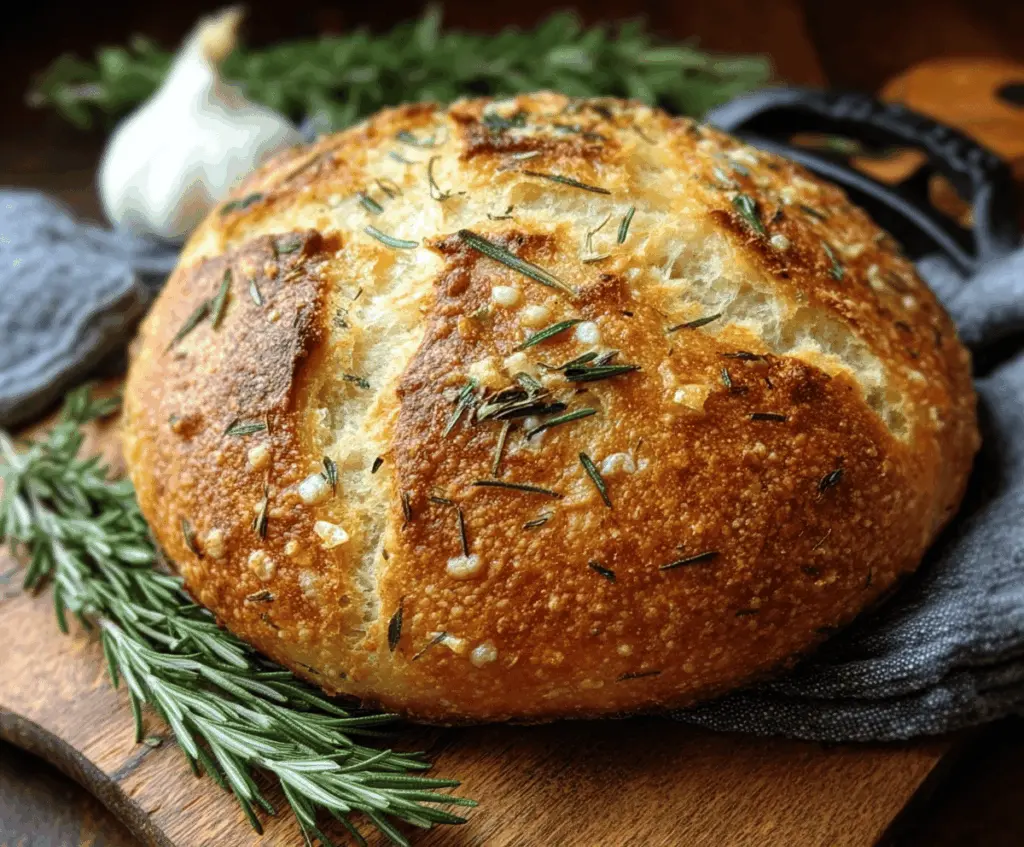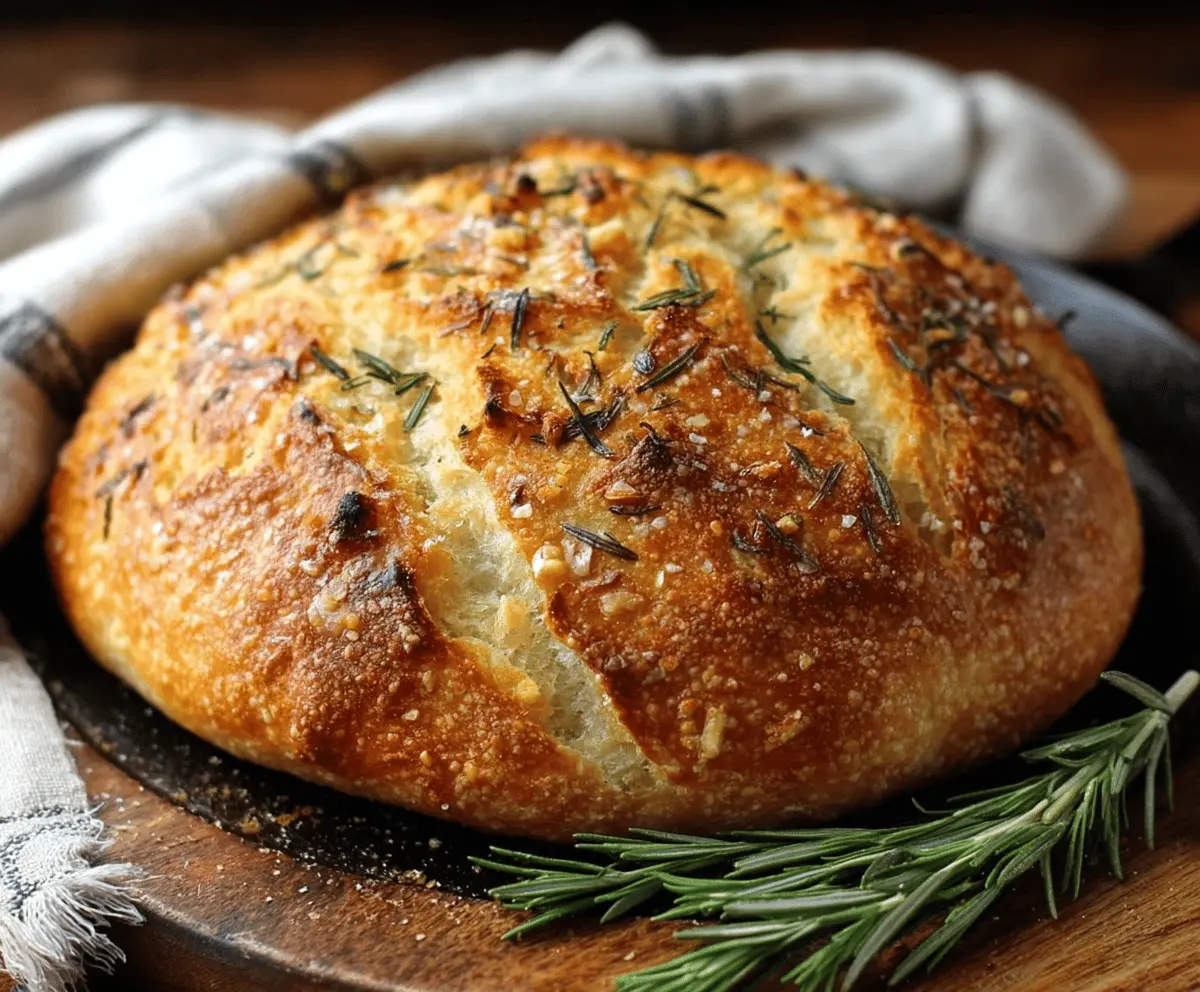
Rustic No-Knead Rosemary Garlic Bread
Rustic No-Knead Rosemary Garlic Bread is a wonderfully simple loaf that feels homemade without all the hard work. With fragrant rosemary and bold garlic woven into the crusty bread, each…
Tip: save now, cook later.Rustic No-Knead Rosemary Garlic Bread is a wonderfully simple loaf that feels homemade without all the hard work. With fragrant rosemary and bold garlic woven into the crusty bread, each slice comes out warm, tender, and full of flavor. The no-knead method makes it easy to throw together, perfect for anyone who loves fresh bread but doesn’t want to spend hours mixing and kneading dough.
I love making this bread when I want something comforting and fresh from the oven, but I’m short on time. The rosemary smell that fills the kitchen while it bakes is one of my favorite things—it’s like a little reminder that good food is on the way. Plus, I don’t have to be a bread expert to get it just right, which feels like a win every time.
My favorite way to enjoy this bread is still warm, slathered with a bit of butter or dipped into olive oil with a sprinkle of salt. It’s perfect alongside a simple soup or salad, or just on its own for a quick snack. I think everyone should try making this at least once because it’s such a nice way to bring a cozy, homemade touch to any meal.
Key Ingredients & Substitutions
Flour: All-purpose flour works great here for a light, airy crumb. If you want a bit more chew and flavor, try bread flour. Gluten-free flours are tricky for this recipe because of the long rise, but a blend marked for bread can work with adjustments.
Yeast: Instant yeast is best for its fast action and no need to proof, but active dry yeast can be used if dissolved in warm water first. If you want to skip yeast, look for sourdough starter recipes but note those need more time.
Rosemary: Fresh rosemary brings that lovely piney aroma and flavor. Dried rosemary can substitute but crush it up to release oils and use less since it’s stronger.
Garlic: Fresh minced garlic is ideal for a bright, punchy taste. If garlic cloves aren’t available, garlic powder can be sprinkled lightly, but it won’t be as flavorful or fragrant.
Olive oil: This adds moisture and a smooth texture to the crust and crumb. You can swap in melted butter for a richer taste or use neutral oils like vegetable oil if needed.
How Can I Make a No-Knead Bread That’s Crispy Outside but Soft Inside?
The secret lies in the long, slow rise and baking method. Here’s how:
- Long fermentation: Letting the dough rise for 12 to 18 hours at room temp develops flavor and gluten without kneading.
- Gentle shaping: Handle the dough lightly just to shape it, keeping the air bubbles for a tender crumb.
- Preheating the Dutch oven: Heating a covered, heavy pot mimics a steam oven, trapping moisture so the crust crisps beautifully without drying out the bread.
- Covered then uncovered baking: Baking covered locks in steam early on, then uncovering lets the crust brown perfectly.
Patience with these steps is key! The result is a rustic loaf with a crunchy crust paired with a soft, flavorful inside every time.
Equipment You’ll Need
- Large mixing bowl – perfect for mixing the dough without making a mess.
- Wooden spoon or spatula – helps stir the sticky dough easily without kneading.
- Parchment paper – makes it simple to transfer the dough into the hot pot and prevents sticking.
- Dutch oven with lid – creates steam for a crisp crust and even baking, you’ll love how it makes the bread crusty outside and soft inside.
- Wire rack – lets the bread cool evenly so the crust stays crisp.
Flavor Variations & Add-Ins
- Swap rosemary for fresh thyme or oregano for a different herby twist that still pairs well with garlic.
- Add ¼ cup grated Parmesan cheese into the dough for a cheesy flavor that’s great with soups or salads.
- Mix in some chopped sun-dried tomatoes for a tangy, slightly sweet bite that brightens the bread.
- Fold in ½ cup olives (chopped) for a salty, Mediterranean flair that works well with the rosemary and garlic.

Rustic No-Knead Rosemary Garlic Bread
Ingredients You’ll Need:
Main Dough:
- 3 cups all-purpose flour
- 1 ¾ teaspoons salt
- ½ teaspoon instant yeast
- 1 ½ cups warm water (around 110°F / 43°C)
- 2 tablespoons finely chopped fresh rosemary, plus extra for topping
- 3 cloves garlic, minced (about 1 tablespoon)
- 1 tablespoon olive oil, plus extra for drizzling
- Coarse sea salt, for sprinkling on top
How Much Time Will You Need?
This recipe requires about 15 minutes of active prep, plus a long resting time of 12 to 18 hours for the dough to rise at room temperature. Then, you’ll do a short 1 to 2 hour final proof before baking. The baking time is about 40 to 45 minutes. It’s a slow process, but mostly hands-off, resulting in fresh, flavorful bread with a crispy crust.
Step-by-Step Instructions:
1. Mix Your Dough:
In a large bowl, combine the flour, salt, and instant yeast. Stir these dry ingredients well. Add the warm water, chopped rosemary, minced garlic, and olive oil. Use a wooden spoon or spatula to mix until the dough forms a sticky, shaggy ball. Don’t knead or overwork it.
2. Let The Dough Rise:
Cover the bowl with plastic wrap or a kitchen towel and let your dough rest at room temperature for 12 to 18 hours. The dough will double in size and become bubbly, showing it’s ready for the next step.
3. Shape the Dough:
Generously flour your work surface and hands. Turn out the dough and gently fold it over a couple of times to shape it loosely into a ball. Avoid pressing too hard, so you keep the air inside. Place the dough seam-side down onto a piece of parchment paper, then cover it with a towel. Let it rest and puff for 1 to 2 hours.
4. Prepare to Bake:
Thirty minutes before baking, place a heavy Dutch oven with its lid in your oven and preheat the oven to 450°F (230°C). The hot pot will help create steam, giving you a perfect crust.
5. Bake the Bread:
Carefully take out the hot Dutch oven. Use the parchment paper to lift and place the dough into the pot. Brush the dough’s top with olive oil, sprinkle extra rosemary and coarse sea salt. Cover with the lid and bake for 30 minutes. Then remove the lid and bake for another 10–15 minutes until the bread’s crust is golden and crisp.
6. Cool and Enjoy:
Remove the bread carefully from the pot and transfer it to a wire rack. Let it cool for at least 30 minutes before slicing—this helps keep the crust crispy. Then enjoy your warm, flavorful rosemary garlic bread fresh or with your favorite spreads and meals!
Can I Use Dried Rosemary Instead of Fresh?
Yes, you can substitute dried rosemary, but use about one-third the amount since it’s more concentrated. Crush it lightly to release the flavors before mixing into the dough.
How Should I Store Leftover Bread?
Keep leftover bread in a paper bag or wrapped loosely in a kitchen towel at room temperature for up to 2 days to maintain the crust’s texture. For longer storage, slice and freeze it in an airtight bag.
Can I Make This Bread Ahead of Time?
Absolutely! After mixing, you can refrigerate the dough for up to 24 hours to slow the rise. Just let it come to room temperature and puff for 1 to 2 hours before baking.
What If I Don’t Have a Dutch Oven?
You can use any heavy, oven-safe pot with a lid, or place a baking tray filled with hot water in the oven to create steam. This helps develop a crisp crust similar to a Dutch oven.
